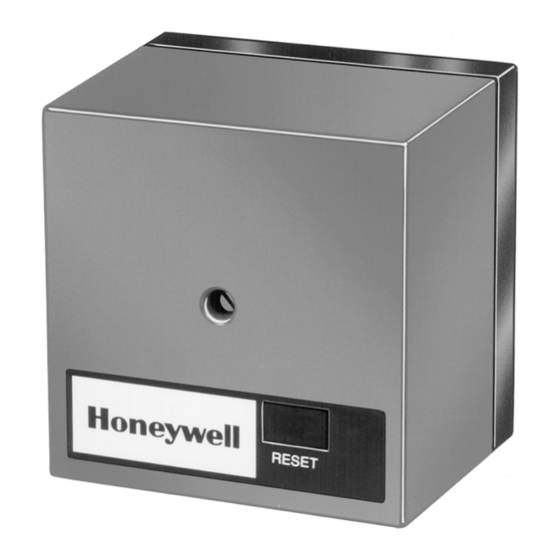
Advertisement
The R7795 Flame Safeguard Primary Control
provides flameout protection plus automatic
control of commercial and industrial gas and
oil burners. Models provide intermittent pilot
or interrupted pilot with delayed main valve.
Integral solid state color-coded flame amplifiers:
R7795A,C for ultraviolet detection systems (purple).
R795B,D for rectification detection systems (green).
See Table 1.
Solid state plug-in ST95A Purge Timers provide
prepurge timings of 1.5, 7, 10, 30, 60, or 90 seconds.
Includes terminals for connection of a line voltage
airflow switch to prove airflow from the start of
prepurge through the run period.
Mounts on a Q795A Subbase with two captive
screws. All electrical connections are automatically
provided between the device and subbase. Wiring
terminals are accessible for testing.
Meter jack on amplifier board for measuring flame
signal with system in operation.
Internal light-emitting diode (LED) indicates pres-
ence of flame signal.
R7795A,B,C,D
Flame Safeguard
Primary Controls
Field selectable ten or four second trial for pilot
flame ignition.
Powered alarm terminal to operate an external line
voltage alarm on safety lockout.
R7795 models are available with either intermittent
pilot (interrupted ignition) or interrupted pilot and
delayed main valve. See Table 2.
Run-Test switch on interrupted pilot/delayed main
valve models.
Safe-start feature prevents start-up with lockout if
flame or a flame simulating failure exists.
Recycle or lockout on flame failure is field selectable.
Safety switch must be manually reset after lockout.
Meets Underwriters Laboratories, Canadian Stan-
dards Association, and Factory Mutual Approved
standards.
CONTENTS
Specifications ................................................. 2
Ordering Information ..................................... 2
Detailed Operating Sequence ........................ 4
Installation ..................................................... 8
Checkout ....................................................... 11
Troubleshooting ........................................... 17
Service .......................................................... 19
B. M. • Rev. 9-93 • ©Honeywell Inc. 1993 • Form Number 66-2001-2
1
66-2001-2
Advertisement

Summarization of Contents
Specifications
Electrical Ratings
Details voltage, frequency, and power consumption of the R7795 control.
Terminal Ratings
Lists load and maximum rating at 120 Vac for each terminal on the R7795.
Ambient Temperature Ranges
Specifies the operating temperature limits for the R7795 control.
Dimensions and Weight
Provides the physical size and weight specifications of the R7795 control.
Approvals
Lists the safety and industry certifications obtained for the R7795.
Accessories
Lists related optional equipment and parts compatible with the R7795.
Detailed Operating Sequence
Standby
Describes the control's ready state before startup.
Normal Start-Up
Outlines the steps from power applied to prepurge.
Pilot Flame Establishing Period
Details the trial for pilot ignition and its timing.
Main Flame Ignition Trial
Describes energizing the main valve after pilot ignition.
Normal Shutdown
Explains how the system stops operation.
Installation
Use of Run/Test Switch
Explains the function of the Run/Test switch on specific R7795 models.
Mounting the Subbase
Instructions for physically attaching the subbase.
Wiring to the Subbase
Guidance on electrical connections to the subbase.
Installing the R7795
Steps for attaching the R7795 control to the subbase.
Wiring Hookups
Shows typical connection diagrams for wiring the system.
Checkout
Equipment Required
Lists necessary tools and meters for performing checkout tests.
Checkout Summary
Overview of the required tests for installation and operation.
Preliminary Inspection
Initial checks to avoid common problems before proceeding with tests.
Flame Signal Measurement
Procedure for measuring the flame signal strength.
Initial Lightoff Checks
Steps for verifying pilot and main flame ignition.
Pilot Turndown Test
Tests pilot flame stability at reduced gas pressure.
Ignition Interference Test
Checks for false signals from ignition spark.
Hot Refractory Hold-in Test
Verifies proper shutdown when refractory is hot.
Ultraviolet Response Tests
Tests response to UV sources and ignition spark.
Safe Shutdown Tests
Verifies system behavior during limit action, flame failure, power failure.
Troubleshooting
Preliminary Inspection
Initial checks to perform before diagnosing issues.
Trouble List
Lists common system problems and their corresponding procedures.
Troubleshooting Procedures
Detailed steps to diagnose and resolve specific system issues.
Service
General Service Precautions
Safety guidelines for qualified personnel servicing the unit.
Periodic Maintenance
Recommended schedule for inspection and testing.
Contact Cleaning
Procedures and warnings for cleaning control contacts.















Need help?
Do you have a question about the R7795C and is the answer not in the manual?
Questions and answers